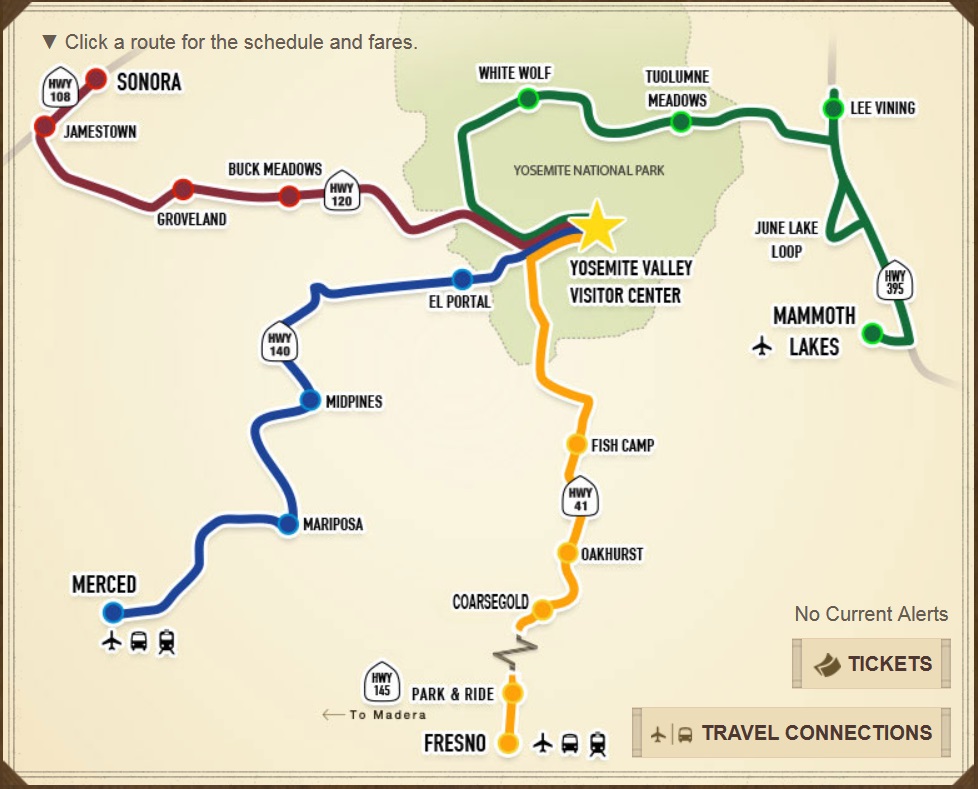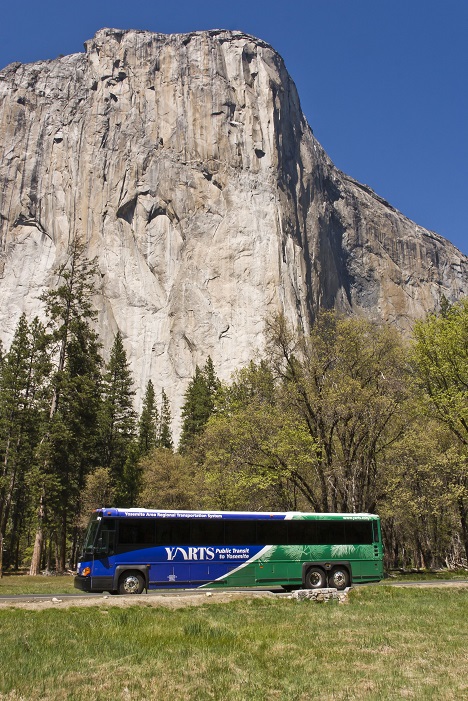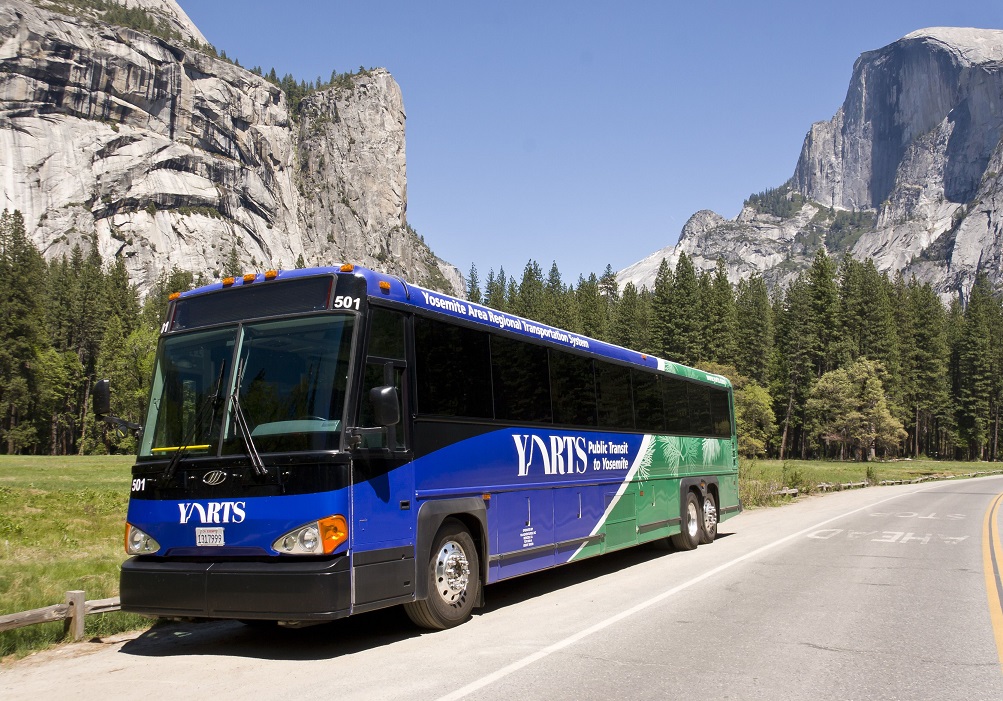MADERA COUNTY – With many years of discussion and planning behind them, The Fresno Council of Governments (COG) and the Yosemite Area Regional Transportation System (YARTS) are about ready to start rolling buses up Highway 41 to Yosemite.
With a target date to start service on Memorial Day weekend, residents and visitors alike will be able to access round-trip public transportation to and from Fresno, through Eastern Madera County and into Yosemite National Park.
The current plan is for four buses a day making the round-trip into the park, and one commuter bus running between Eastern Madera County and Fresno. That bus will have an early-morning departure time from Oakhurst, accommodating people who need to arrive early at work, school or appointments.
The schedule will not be finalized until about May 1, but the basics are in place. There will be a stop at Coarsegold’s Historic Village and at least one in Oakhurst before the bus heads up to the Tenaya Lodge, Wawona, and several locations in the Yosemite Valley, where riders can connect with the free shuttle service. The plan also includes a stop at the Chukchansi Casino in Coarsegold if and when the facility is re-opened. Trying to identify a location for a Park & Ride lot in Oakhurst is also in the works.
Dick Whittington, YARTS Transit Manager with the Merced County Association of Governments (MCAG), says they are in the final stages of scheduling and identifying stops along the route, and sees the project as delivering great value to the business and residents of Madera County.
“On one end of Highway 41 you have the largest city in the Central Valley and the largest airport, plus Amtrak and Greyhound,” says Whittington. “On the other end you have Yosemite National Park with its 4 million visitors every year. Connecting them just makes sense.”
Passengers will be able to board the bus at Fresno Yosemite International Airport (FYI), the Greyhound Bus Depot or the Amtrak Station in downtown Fresno. YARTS is also working with Fresno Area Express (FAX) to utilize some of their existing stops to make connecting with the bus service even more convenient.
Another part of the process, says Whittington, is discussions with the Madera County Transportation Commission (MCTC) about how YARTS and the Madera County buses can connect to the benefit of riders. The Madera County Connections (MCC) bus service currently runs from Madera to Yosemite Lakes Park, Coarsegold, Oakhurst, Bass Lake and North Fork.
“One of the things we’re trying to do is work with MCTC to create connectivity between our systems,” says Whittington. “We would like to jointly establish bus stops in Oakhurst, and increase the ability for locals and visitors to get around the mountain area. The MCC buses go places we aren’t going, such as Bass Lake and North Fork, and with our service covering the Highway 41 corridor, it may free up some of the MCC budget to move around the mountain area more.”
Dylan Stone, Regional Planning Supervisor for the MCTC, says they are very much interested in having the operators collaborate and look at opportunities for better connectivity in the gateway communities.
“You try to avoid redundancy and not get too much overlap, so with the larger buses servicing the Highway 41 route, we can look at possible schedule changes to make sure there’s good connectivity with the other systems,” says Stone. “It creates the possibility for a little more flexibility with what the MCC buses can do, and we might be able to expand some of those routes.”
 Whittington says they are also in discussions with Cal Trans about using the Park & Ride at Highways 41 and 145, allowing people to leave their cars and travel to Yosemite or work destinations.
Whittington says they are also in discussions with Cal Trans about using the Park & Ride at Highways 41 and 145, allowing people to leave their cars and travel to Yosemite or work destinations.
The fare for a round-trip from Fresno to Yosemite will be $30, and children under age 12 ride free with a paid adult. The fare from Oakhurst/Coarsegold will be $15 round-trip. (Click to enlarge map).
Riders can purchase tickets from the driver, and with a card reader on the bus, they can just swipe an ATM or credit card upon boarding.
Another piece of the connectivity puzzle is the contract with Amtrak, making the YARTS service part of Amtrak’s Thruway Bus system. Travelers can log onto Amtrak’s website and purchase tickets, board the bus in Oakhurst, for example, and transfer to the train at the station. It will all be part of the same transaction, with passengers able to print off tickets from their computers for the entire trip, returning to the mountains without having to leave their cars at the airport or the train station.
Currently, visitors who fly in to FYI, and can’t or don’t want to drive, have to make their way to the Fresno Amtrak Station and ride a train to Merced to catch a YARTS bus into Yosemite, bypassing Highway 41 altogether.
“Whether people fly in, ride in on a bus, or come by train to Fresno, they will now be able to connect directly and travel to the Oakhurst area and on to Yosemite,” says Whittington.
Via Adventures is the company that contracts with YARTS for drivers, maintenance, fueling and dispatch. YARTS currently owns 10 MCI buses, and Via Adventures has recently added 4 more to their Via-owned fleet, which will be dedicated to the Highway 41 service.
Whittington says the Highway 41 project will provide a significant improvement in the service between the Yosemite Valley floor and Wawona. There is currently only one bus a day on that route, and it does not operate between Labor Day and Memorial Day. The YARTS service will run 365 days a year, stopping at the Wawona Store, and also at the Wawona Hotel during the season.
For those who now only have the option of renting a car to travel from Fresno to Yosemite, the buses will offer an alternative that could prove attractive in the wintertime when tire chains are required in the higher elevations, says Whittington. Rental cars do not come equipped with chains, you have to buy them, and any insurance is voided when damage is caused by their use, says Enterprise Rent-A-Car.
YARTS currently operates year-round on Highway 140 through Mariposa County with multiple runs each day. There is also daily service from Mammoth Lakes and Mono County during the summer (typically June through September), when Tioga Pass Road is open, and between Sonora and Yosemite Valley from Tuolumne County. With the addition of the Highway 41 service, all four park entrances will now be accessible via public transportation.
With parking at a premium in Yosemite Valley, Whittington says YARTS enhances the visitor experience by helping to cut back on the space needed for employee parking.
“About 35 percent of our ridership on the Highway 140 route is commuters, many of whom work in Yosemite,” says Whittington. “For every one of those employees who chose to ride the bus, that’s one more car that isn’t there, leaving a vacant parking space for somebody else. And not just one; there’s turnover as visitors come and go throughout the day, allowing that space to be used several times. That enhances the quality of the visit and reduces congestion.”
He also notes the benefits to employees who work in the park and don’t have cars.
“Offering them a convenient way to travel out of the park makes them customers in the surrounding communities,” says Whittington.
Some background on YARTS
 YARTS was created in 2000 as a California Joint Powers Authority, which is a governmental organization formed by two or more public entities combining to accomplish a specific goal – in this case, regional public transportation. The three member counties in YARTS are Merced, Mariposa and Mono Counties, with two Supervisors from each county holding a seat on the board.
YARTS was created in 2000 as a California Joint Powers Authority, which is a governmental organization formed by two or more public entities combining to accomplish a specific goal – in this case, regional public transportation. The three member counties in YARTS are Merced, Mariposa and Mono Counties, with two Supervisors from each county holding a seat on the board.
YARTS has no employees, but rather contracts with Via Adventures to provide the service in the member counties. The Fresno Council of Governments (COG) is sponsoring the Highway 41 project, and the contract between the Fresno COG and YARTS is a net-zero contract, wherein Fresno COG covers all expenses, and YARTS neither profits nor incurs any expenses.
Though Madera County has historically voiced strong opposition to the project – from the Board of Supervisors, the Oakhurst Area Chamber of Commerce and the Yosemite Sierra Visitors Bureau – YARTS Regional Manager Dick Whittington asked for and received approval from his board to include a representative from both Madera and Tuolumne Counties on the YARTS Board. Though neither county is contributing financially to the project, two non-voting seats have been created, and were filled by District 5 Supervisor Tom Wheeler and Tuolumne County Supervisor John Gray.
“They can speak and participate in the discussion,” says Whittington. “It gives them an opportunity to talk about how the service works and what their needs are. We think that’s important.”
The YARTS Board also has an Authority Advisory Committee, and Darin Soukup, Oakhurst Area Chamber of Commerce Executive Director, has been chosen by Tom Wheeler to serve on the committee.
After Fresno COG approved the Highway 41 project in 2010, they directed staff to move ahead with securing funding, which they received from several sources. The majority of the $2,380,000 annual budget comes from the Congestion Mitigation Air Quality Improvement Program (CMAQ), which is federal grant money available for projects in areas that have air quality problems. Both Fresno and Madera Counties qualify for CMAQ funding.
Another source of funding is the Federal Transportation Department’s Intercity Bus Program, which requires states to spend a certain percentage of these funds in support of projects that connect isolated rural areas throughout the country to larger communities.
Other contributors to the project are the National Park Service, the San Joaquin Valley Air Pollution Control District and Amtrak. Income will also be generated through passenger fares.
The project is funded for two years, during which time it will be continually evaluated and adjusted to address the needs of riders and dial in the schedule, the stops, and the number of buses needed, says Whittington, who encourages everyone to visit the YARTS website and share their comments to assist in improving the service.
“This first year will be a front-to-back learning experience, trying to get it working the best way possible,” says Whittington. “We encourage feedback. One of the things that’s really important to me is that if you perceive a problem, we want you to tell us; otherwise we can’t address it and improve on what we’re doing.”
Whittington says they have regularly made changes to their operations as a result of rider input, and never consider constructive comments as complaints.
“If we’re not doing something right, or there’s a way we can improve, we want to hear people’s ideas about it,” he says. “We can’t always make the suggested changes, but we do always listen.”
With the bus service now a reality, the Oakhurst Area Chamber of Commerce, with the participation of Executive Director Darin Soukup on the Advisory Committee, is looking into ways to make the project work to the benefit of mountain area businesses.
“The Oakhurst Area Chamber of Commerce is committed to working with Fresno COG and their transit partner, Madera County, along with local business partners now that the new public transit service will begin this summer,” says Soukup. “It is vital that our local business community find ways to take advantage of the eminent public transit service along the entire Highway 41 corridor.
“The local Chambers of Commerce, business owners, and other community stakeholders are going to have to work hard to translate the ridership into tourism dollars spent in Eastern Madera County. The last thing anyone wants is for ridership to stay on the bus without getting off somewhere along the Highway 41 corridor. We need to educate the potential ridership and share a compelling story with the visitors so they know they can step off of the bus and enjoy a full mountain experience while in Eastern Madera County.”
In response to the most vocal opposition, who object to public funding for the Highway 41 project, Whittington points out that all public transportation is government subsidized.
“That includes highways, airlines, trains and buses,” he says. “The state of California requires rural transit to have at least a 10% fare box recovery. YARTS has averaged between 23 and 26 percent.”
Whittington encourages those opposed to the project to get involved in the process and participate in making it work for everyone. District 5 Supervisor Tom Wheeler agrees.
Though Wheeler was initially against the Highway 41 bus project, he saw the writing on the wall some years ago, and knew that the buses were coming, “whether we like it or not. We can either sit and watch them go by, or we can figure out how to make it benefit our county, our citizens and our businesses.”
Wheeler sees the new service as a win-win situation.
“This is a perfect system to get to Yosemite, and that’s not counting the benefits that we’re going to get to our communities,” he says. “A lot of senior citizens are excited to be able to get to Fresno and to doctor’s appointments without having to drive. It’s taking those cars off the road. So, bottom line, we’re either going to participate, or we’ll lose out. It’s coming anyway, and instead of just watching it go by, we need to get on the bus.”




